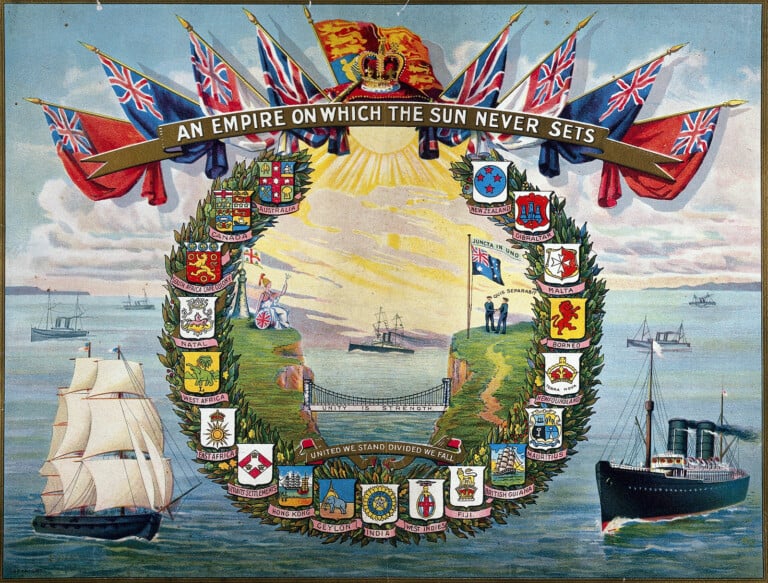Introduction
The Anglo-American World is but colonial. Its present extension is the result of England’s self-affirmation and ambition to become a major world power. Therefore, the words “empire” and “imperialism” describe England’s struggle for national and international sovereignty.
The first consequence of English expansionism was the westward impulse of the Anglo-Saxon element, first into the Celtic periphery of the British Isles, then across the Atlantic and finally into Africa and Australasia.
The second more recent consequence is the emergence in the 20th century of multi-cultural societies both in Britain and in America but also across the British Commonwealth, which is constituted of the former British colonies.
Early English expansionism in the British Isles
The origin of British colonial adventures lies in the early steps taken by English Kings towards the political, economic, and religious integration of the British Isles.
The Anglo-Norman enterprise
In 1066, William, Duke of Normandy, became the master of England. His successors, the Anglo-Norman Kings, tried to increase their authority and international prestige (especially in front of France) by controlling the British Isles (first Ireland and then Wales).
In 1171, the English King Henry II landed in Ireland and was accepted by the Irish Kings as their overlord (=master). During the 13th century, many Anglo-Norman barons settled in Ireland where they were given land by the King. They introduced the French system of feudalism and forced the native Irish to become serfs.
In 1366, the English Parliament prohibited mixed marriages between Irish and Anglo-Norman and Irish laws and customs were abolished in English-controlled areas. The colonization of Ireland had started.
In 1277, Edward I of England invaded Wales after the last Prince of Wales refused to acknowledge his authority. The country soon became part of the English Royal Estate and was re-organized into 5 countries, after the English model. In 1301, the English King became the Prince of Wales.
The Anglo-Normans never managed to conquer Scotland. After a series of unsuccessful invasions, the English were finally forced out in 1314. Scottish independence was secured for 4 centuries.
Post-Reformation settlements
By consolidating royal power, the reformation indirectly encouraged England to extend its control over the British Isles.
In 1541, King Henry VIII, who had become head of the English church as well as of the State, was proclaimed King of Ireland. The actual colonization of Ireland started in 1586 with the creation of the Munster Plantation in the South of Ireland.
Later on, in 1608, Scottish and English settlers were encouraged by the Government to cross the Irish Sea and to create farms in Ulster. This new settlement was the origin of contemporary Protestant Northern Ireland. In 1652, 2/3 of Irish land was given to Protestants.
Between 1536 and 1543, a series of administrative measures put Wales in a situation of total dependence on English legislation.
The situation of Scotland was different: between 1603 and 1707, Scotland remained a separate independent Kingdom but under the same King as England.
Formation of the old colonial empire
From trading posts to early settlements
A trading post is a place to carry on commercial business; it may be temporary and doesn’t imply settlement.
Right after the discovery of the New World in 1492, England’s self-affirmation as an independent and dominant European power led her to compete against Spanish and Portuguese colonial monopolies.
In 1494, by the treaty of Tordesillas, Spain and Portugal had divided the Western Hemisphere between Spanish and Portuguese possessions. In answer, England decided to send explorers to the New World.
In 1497, the Italian Sea Captain John Cabot explored the northern coast of America on behalf of the English King. He called the land he had recognized “Newfoundland”.
Later on, in 1577, an English Captain explored the West Coast of America: Francis Drake called the American Pacific sea coast “California”, the legendary name of a mythical Eden.
Finally, in 1584, another sea captain, Sir Walter Raleigh, explored the Atlantic American coast for the Queen of England and called the place “Virginia” to celebrate his queen as the Virgin Queen.
In 1588, England took the status of a major sea power after defeating the Spanish fleet, the “Invincible Armada”. This early colonial experience had secured English mastery of the sea. It was the starting point of the Spanish decline.
In economic terms, several colonial joint-stock companies, in which several people invested money to found the colonial empire, were created in England. In 1600, the East India Company was created to favor trade with the East.
In 1606, 2 companies were created to encourage trade with America:
- Plymouth Company for the Northern part of the coast
- London and South Virginia Company for the Southern coast.
In 1672, the Royal African Company was given the monopoly of trade with Africa (and slavery). Therefore, the rise of Capitalism corresponds to that of colonialism.
In human terms, the first successful and permanent English settlement in America was established in May 1607 with the creation of Jamestown in Virginia by adventurers and merchants in search of fortune.
A different experience took place in September 1620, when an English ship called the Mayflower reached the place later called Plymouth Rock with a small group of English dissidents on board, the famous Pilgrim Fathers.
This first successful Puritan colony in America was motivated by religious reasons. From 1620 to 1640, some 25000 English independents took refuge in New England. The 3rd category of people who reached America was African slaves.
In 1619, the first shipload of slaves was brought to America on a Dutch ship. Finally, the last category of people in America is Native Americans. They proved to be essential to the survival of settlers in America.
The beginning of the European settlement gave the illusion of peaceful coexistence between European settlers and Native Americans.
In 1640, a rich colonist called John Rolfe married the daughter of a local chief, Pocahontas. Another Indian tribe helped the Pilgrim Fathers to avoid starvation by teaching them how to plant corn.
However, the respected interests of both communities soon became opposed. The increase in the European population resulted in several problems over land ownership and the American settlers soon started to displace the Indian population and sometimes used military action.
The original dream of peace turned into a bloody nightmare. Americans, however, were relieved to think their treatment of the Natives had never reached the savagery that was typical of Spanish colonization.
Mercantilism or the establishment of the colonial system
Apart from international prestige, the colonists constituted a vast and permanent captive market for English goods. It was also a source of raw materials and finally, it represented a convenient exile for embarrassing subjects.
The colonists played a major role in the definition of the new international economic system called mercantilism.
It was based on strict regulations protecting the home market and establishing monopolies on all exchanges with the colonies.
Between 1651 and 1662, a series of Navigation Acts gave English ships exclusive control of all trade to and from the colonies.
This excluded all foreign nations and all colonial organizations from trading across the Atlantic: to secure new markets and new sources of raw materials, the system demanded continual expansion through wars and invasions. The struggle for empire had started a long time before the late 19th century, called the Scramble for Africa.
The essential part of trade consisted of the famous “triangular trade” with the New World. Three geographical regions were involved in the triangle:
- Western Europe
- Africa
- North America and the West Indies
Because of mercantilist regulations, most goods including African slaves had to transit either through England or through the West Indies.
This economic situation was considered unfair by a majority of colonists. It was one of the origins of the American Revolution.
The first British colonial empire
Lasted until the American independence, which took place between 1776 and 1783. This empire had two major posts: India and North America.
The stream of emigrants was directed towards America but in both cases, England and then Britain became involved in colonial wars against Holland, Spain, and France to protect and extend their trading interests.
England had started trading with India in the late 18th century. The East Indian Company (EIC) was founded in 1600.
The 18th century saw the decline of the Indian Empire (Mogul) and military agreements with local leaders.
After 1757, the EIC controlled all trade with the West Coast of India, Bengal, and Ceylan (Sri Lanka today).
In 1760, the French were defeated and driven out of India, except for a couple of trading posts that she kept on the coast such as Pondichery.
In 1773, Britain started to control India through a governor based in the town of Bombay.
In 1640, sugar cane agriculture was introduced in Barbados. In 1655, the English took Jamaica from Spain: it marked the beginning of the Spanish decline in the Caribbean.
On the American continent, the 18th century saw total domination of Britain on colonial land. In 1667, England invaded New Amsterdam, which later became New York.
After the 7-year-old war with France in 1763, England took control of the French West Indies, of all French Canada, and of the whole French territory between the East Coast of America (New England) and Mississippi. Finally, England took Florida from Spain.
In 1763, British King George III issued a royal proclamation leaving the rich Ohio Valley to the Native American tribes that had helped the British against France. This political measure disappointed the settlers who feared overpopulation in New England. This was the second origin of the American Revolution.
In the 1760s, the population of New England which was divided into 30 colonies had already reached 2.5 million inhabitants and 275 000 slaves were transported to America during the 18th century. 90 % were to be found in the South.
The loss of the American colonies in 1783 marked the end of the first colonial empire, yet, a second one was already forming in other parts of the world.
The second colonial empire
Australasia. In 1768, the British captain James Cook had already explored the coasts of Australia and New Zealand. After the discovery of Botany Bay which later became Sydney, a penal colony was established in Australia in 1788.
Prisoners and convicts were transported to Australia for hard labour. The settlement started much later in New Zealand, with a treaty with local Maori chiefs in 1840.
Africa. Before the 1880s, i.e. the Scramble for Africa, Britain showed little interest in the African continent. The government’s major occupation, apart from the slave market, was to secure the sea route to India. Therefore, Britain took the Dutch colony at the Cape (South Africa) in 1806.
Then, Britain insisted on receiving Mauritius in the Indian Ocean. Later, Britain secured other places on the sea route to Suez (e.g.: the island of Malta). However, Britain accepted the responsibility of protecting a colony of liberated slaves in Sierra Leone founded in 1788.
Asia. The expansion started much later when Britain took Singapore in 1824. Later, in 1841, Britain established a trading post in Hong Kong she kept until July 1997.

